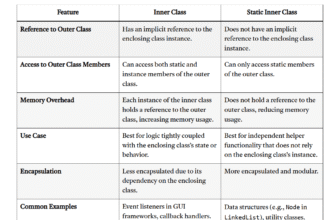Introduction
Java is one of the most popular programming languages today, and understanding its core features is key for writing clean and efficient code. One feature that often confuses beginners is the copy constructor in Java. But don’t worry! By the end of this article, you will clearly understand what a copy constructor is, how it works, and why it’s useful.
In simple words, a copy constructor is a special type of constructor in Java that creates a new object by copying data from an existing object. Think of it like making a twin of an object with all the same properties and values. This concept is not just a programming trick; it’s widely used in real-world applications to simplify object management.
In this article, we’ll break everything down step by step. We will explore definitions, syntax, types, examples, best practices, common mistakes, and more. By the end, you’ll feel confident using copy constructors in your Java projects.
What is a Copy Constructor in Java?
A copy constructor in Java is a constructor that takes another object of the same class as a parameter and copies its values to create a new object. Unlike normal constructors, which initialize an object with new values, a copy constructor initializes an object using data from an existing object.
For example, imagine you have a Book object with a title and author. Using a copy constructor, you can create another Book object with the same title and author without setting each property individually. This makes your code cleaner and reduces the chances of errors.
Copy constructors are particularly useful when you want to create a deep copy of objects, meaning the new object doesn’t share memory with the original object. We’ll dive into shallow vs deep copying later.
Why Use a Copy Constructor?
You might wonder why you need a copy constructor when you can just assign one object to another. The problem is that simple assignment only copies the reference, not the actual object. This can lead to unexpected bugs if one object is modified.
A copy constructor solves this problem by creating a completely new object with the same data. This is important in situations like cloning objects, undoing changes in applications, or working with immutable objects.
For instance, in a banking application, if you copy an account object using a reference, updating the balance in the new object will also change the balance in the original object. A copy constructor prevents this by creating a separate object with the same initial data.
Syntax of a Copy Constructor in Java
Creating a copy constructor in Java is straightforward. Here is the general syntax:
class ClassName {
// Attributes
int value;
// Copy Constructor
ClassName(ClassName obj) {
this.value = obj.value;
}
}
Let’s break it down:
ClassName(ClassName obj)is the copy constructor.- The parameter
objis the existing object you want to copy. this.value = obj.valuecopies the value of the attribute from the existing object to the new one.
You can have multiple attributes, and the copy constructor will copy all of them individually.
Example of Copy Constructor in Java
Here’s a simple example to see a copy constructor in action:
class Person {
String name;
int age;
// Normal Constructor
Person(String name, int age) {
this.name = name;
this.age = age;
}
// Copy Constructor
Person(Person p) {
this.name = p.name;
this.age = p.age;
}
void display() {
System.out.println("Name: " + name + ", Age: " + age);
}
}
public class Main {
public static void main(String[] args) {
Person original = new Person("Ravali", 25);
Person copy = new Person(original);
original.display();
copy.display();
}
}
Output:
Name: Ravali, Age: 25
Name: Ravali, Age: 25
Here, copy is a new object with the same properties as original, created using a copy constructor.
Shallow Copy vs Deep Copy
Understanding shallow copy and deep copy is crucial for working with copy constructors.
- Shallow Copy: Copies only primitive data types and references. Objects inside the original object are shared, not copied. Changes in nested objects affect both original and copied objects.
- Deep Copy: Copies primitive data and creates new instances for objects inside. Changes in the copied object do not affect the original.
In Java, default copy constructors perform a shallow copy. To make a deep copy, you need to manually copy nested objects inside the constructor.
Advantages of Using a Copy Constructor
Using a copy constructor has several benefits:
- Code Simplicity: You don’t need to write repetitive code to set each attribute.
- Data Safety: Prevents unintentional changes to the original object.
- Flexibility: Useful in implementing prototypes or cloning objects.
- Efficiency: Makes object creation faster and cleaner when you need a duplicate object.
For example, in a game application, you may want multiple players with the same default stats. A copy constructor lets you quickly create new player objects without manually setting each property.
Copy Constructor with Arrays
Copy constructors are also useful for copying arrays. Arrays are reference types in Java, and assigning them directly can cause shared memory issues. Here’s how a copy constructor works with arrays:
class Numbers {
int[] values;
Numbers(int[] values) {
this.values = values;
}
// Copy Constructor
Numbers(Numbers n) {
this.values = new int[n.values.length];
for (int i = 0; i < n.values.length; i++) {
this.values[i] = n.values[i];
}
}
}
This creates a deep copy of the array, ensuring the new object does not share memory with the original.
Common Mistakes with Copy Constructors
Even experienced programmers make mistakes when using copy constructors. Here are some common ones:
- Shallow Copy When Deep Copy Needed: Copying only references instead of creating new objects.
- Not Copying All Attributes: Forgetting to copy some fields, leading to inconsistent data.
- Infinite Recursion: Accidentally calling a copy constructor within itself.
- Confusing Assignment with Copying: Using
=instead of a copy constructor copies references, not objects.
Always review your copy constructor carefully to avoid these pitfalls.
Copy Constructor with this Keyword
The this keyword plays a critical role in copy constructors. It refers to the current object and is used to differentiate between the object being created and the object being copied.
Example:
this.name = obj.name;
Here, this.name refers to the new object, and obj.name refers to the original object. This ensures proper copying without conflicts.
Copy Constructor vs Clone Method
Java also provides the clone() method for copying objects. But how is it different from a copy constructor?
- Clone Method: Part of the
Objectclass. Needsimplements Cloneableto work. Can throwCloneNotSupportedException. Often shallow copy by default. - Copy Constructor: Simple, flexible, doesn’t need extra interfaces. Can easily implement deep copy.
Many developers prefer copy constructors for clarity, safety, and control over copying behavior.
Real-Life Examples of Copy Constructors
Copy constructors are widely used in Java applications:
- Games: Creating multiple characters or items with default stats.
- Banking Apps: Creating snapshots of account data for transactions.
- E-commerce: Cloning product objects with similar attributes.
- Social Media: Copying user profiles to test new features without altering original data.
These examples show how essential copy constructors can be in real-world software development.
Best Practices for Copy Constructors
Follow these tips to write effective copy constructors:
- Always copy all relevant fields.
- Use deep copying for mutable objects like arrays or custom objects.
- Avoid calling other constructors inside the copy constructor unnecessarily.
- Keep it simple and readable.
- Document the constructor behavior clearly for other developers.
FAQs About Copy Constructor in Java
1. Can Java create a copy constructor automatically?
No, Java doesn’t provide a default copy constructor. You must define it manually.
2. Does a copy constructor perform deep or shallow copy?
By default, it performs a shallow copy. You must implement deep copy manually.
3. Can copy constructors throw exceptions?
Yes, like any constructor, a copy constructor can throw exceptions if needed.
4. Is copy constructor used in inheritance?
Yes, subclasses can call the superclass’s copy constructor to copy inherited fields.
5. Difference between copy constructor and assignment operator?
Assignment copies the reference, not the actual object. Copy constructor creates a new object.
6. Can we overload a copy constructor?
Yes, you can have multiple constructors with different parameters, including copy constructors.
Conclusion
The copy constructor in Java is a powerful tool for creating new objects based on existing ones. It simplifies code, prevents bugs, and ensures data safety. Whether you’re dealing with simple objects, arrays, or complex classes, understanding copy constructors helps you write cleaner and more efficient Java programs.
Next time you need a duplicate object, think twice before using a simple assignment. Using a copy constructor ensures your program behaves as expected. Practice implementing both shallow and deep copy constructors, and you’ll see your coding confidence soar.









